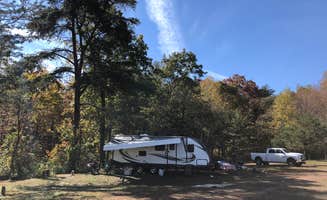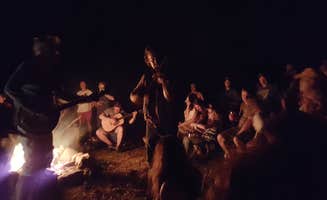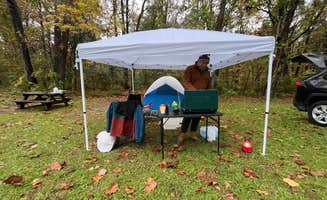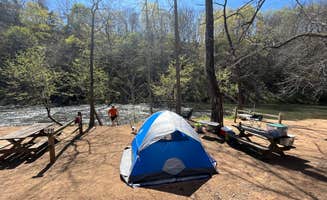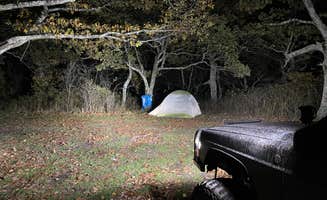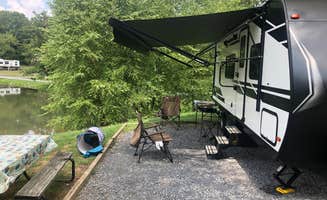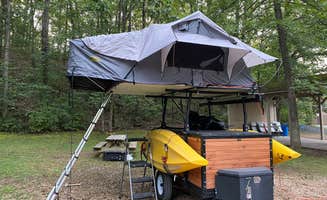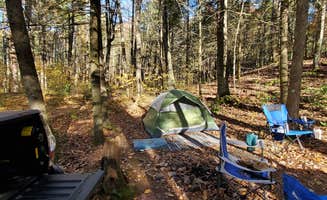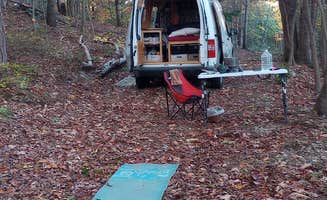Dispersed camping sites near West Augusta, Virginia range in elevation from 1,300 to 4,500 feet across the George Washington National Forest. The region's higher elevations often result in temperatures 10-15 degrees cooler than surrounding valleys during summer months. Most primitive camping areas require visitors to pack out all waste and bring water treatment systems, as natural sources may require purification.
What to do
Fishing opportunities: The pond at Braley Pond Dispersed Camping & Day Use Area is regularly stocked with trout during fishing season. "The pond is stocked with trout in season, check DGIF site for dates," notes Paul P., who appreciates the off-grid experience. During spring and early summer, stream fishing is also available along the creek that runs through the camping area.
Trail exploration: Multiple hiking paths connect directly to campsites throughout the forest. At Hone Quarry, visitors can access waterfall trails from their sites. One camper reports, "We went to the first site after the lake and it was fairly flat and open. And we were right by the trail that goes to the waterfall." The campground serves as an ideal basecamp for exploring the surrounding wilderness.
Night sky viewing: The absence of light pollution makes stargazing exceptional at higher elevation sites. At Flagpole Knob, camping areas offer unobstructed views. "The sunset and sunrise views are insane," according to Sydney D., who camped there solo with just a dog. Several dispersed sites throughout the forest provide similar dark sky conditions ideal for astronomical observation.
What campers like
Solitude and privacy: Many campers value the sense of isolation available at dispersed sites. "This place makes it seem as if you're alone," writes Jonny D. about Braley Pond Dispersed Camping & Day Use Area. For even greater seclusion, primitive sites along forest service roads often have minimal occupancy even on weekends.
Creek-side sites: Camping beside flowing water ranks high with visitors. At North River Campground, campsites along the creek provide natural water features. "Great small campground with 9 sites and vault toilets up the mountain nestled by a stream. Quiet and relaxing!" shares Michelle B. Similar stream-adjacent sites can be found at several locations throughout the national forest.
Geological features: The unique rock formations at Natural Chimneys County Park attract geology enthusiasts. One visitor reports, "The Natural Chimneys are awesome. The park is flat with nice campsites and a stream that varies from year—it runs underground some years." These limestone formations create distinctive camping backdrops not commonly found elsewhere in the region.
What you should know
Cell service limitations: Nearly all camping areas have minimal or no cellular connectivity. At North River Campground, one camper noted, "There's no service for Verizon, but if you have an emergency, you can drive a mile or two and send out a call." Similar conditions exist at most forest sites, requiring campers to plan for offline navigation and communication.
Flooding concerns: Low-lying camping areas may experience water issues after heavy rain. "This area is fairly low, and the road and sites can easily be soaked, if not underwater after really heavy rains," cautions Dave P. about Braley Pond. Several campgrounds in the region sit in potential flood zones, making weather monitoring essential before and during visits.
Vehicle requirements: Some dispersed camping areas require appropriate transportation. For accessing Flagpole Knob, Adrian F. advises, "Recommend vehicles with some ground clearance depending on which route you take up." Forest service roads leading to remote sites often deteriorate during wet conditions, creating challenging driving situations.
Tips for camping with families
Swimming options: Several campgrounds offer water recreation suitable for children. George Washington National Forest Todd Lake Campground provides swimming opportunities in addition to hot showers. Lucy P. describes it as "beautiful and fun place for swimming, hiking, and mountain biking." The designated swimming areas offer safer alternatives to creek wading.
Kid-friendly amenities: Campgrounds with playgrounds and open spaces work best for families with young children. At Walnut Hills Campground & RV Park, facilities include "a very nice playground and a pet exercise area. You can fish in the lake," according to one visitor. The structured environment provides activities when children need breaks from hiking.
Wildlife education: Several camping areas offer opportunities to observe small wildlife safely. At Shenandoah Valley Campground, Ryan Z. notes, "My kids loved all the bunnies, the river, pool and putt-putt." These interactions create educational opportunities about local ecosystems and animal habitats.
Tips from RVers
Site selection strategy: RV campers recommend researching site specifications before booking. At Shenandoah Valley Campground, one RVer observes, "The camper section is very tight, whereas the tent sites look more roomy." Many campgrounds have limited pull-through sites, requiring advance planning for larger rigs.
Seasonal availability: Most RV-friendly campgrounds operate on limited schedules. Natural Chimneys Regional Park offers full hookup sites but follows seasonal opening patterns. "Passing thru, we were amazed by the formations in the park. Having a grass lot that was extremely spacious with shade doesn't happen very often with a 40'er," notes Fred R., highlighting the importance of confirming availability for larger RVs.
Dump station access: RV campers should note which facilities provide sanitary dumping. Walnut Hills Campground maintains year-round facilities, while forest service campgrounds like North River offer more limited services. Planning multi-day stays requires careful water usage management at locations with fewer amenities.



